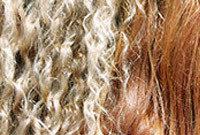Notorious for its dryness, unpredictability and lack of control, curly hair is one of the most difficult to manage hair types. But before you reach for that straightening iron, remember that the key to great hair is not how you style it, but how you care for it.
The best way to achieve shiny, healthy, frizz-free curls is by looking after your locks and tailoring your hair care routine so it works for your curls, not against them.
Cutting
Cutting curly hair every 4 to 6 weeks will not only keep your tresses in top shape, it will also stop the ends from losing their curl and going straight. Layering curly hair can make it easier to handle and achieve hairstyles, but make sure the hairdresser doing the layering understands curly hair and how your curls will fall when layered. A good stylist will be able to advise you on a haircut that will make the most of your curls.
Washing
To care for curly hairstyles, washing is important, but washing everyday can strip the hair of its natural oils, which are the best way to keep your curls healthy. It is a good idea to use a shampoo and a conditioner that is designed specifically for curly hair and that is full of moisturizers but also has frizz reducers.
- Work shampoo through your scalp and let the suds run through the rest of your hair.
- Apply conditioner to the mid lengths of your hair and then work it down to the ends. If your hair is especially dry, apply more conditioner to the ends and comb it through the hair.
- Always use warm water to wash your hair. Hot water will dry curls out.
- Using a deep moisturizing treatment once a week will keep curls strong without going frizzy and a hot oil treatment once a month will add vitality and shine. Blotting the hair with paper towels to soak up excess water is a great way to dry without causing frizz and a wide-tooth comb is the best styling tool.
Styling
Never brush curly hair as it will promote frizz and damage the cuticle. Instead, use a wide-tooth comb or your fingers to gently detangle the hair. Avoid any styling products that contain alcohol or ones that will weigh the hair down. It is a good idea to only use hair-dryers when absolutely necessary as the heat will zap curly hair of moisture and is the fastest way to create frizz and fly-aways.
- Whenever styling, always moisturize the hair first with a simple body moisturizer before applying styling products. The moisturizer will keep the hair protected from damage and reduce static and frizz.
- To get your hair to fall into its natural curly shape, style when wet and then leave your hair to air dry and try to resist scrunching or touching.
- Sleeping in wet hair will guarantee out-of-control curls. Combat this by braiding or plaiting your hair in three separate sections and by resting your head on a satin pillowcase so that your hair doesn’t rub.
- Wear your hair with a soft side parting that is not too defined for a flattering look.
- Using a sea salt spray is a great way to redefine curls and texture and revitalize styling products.
Common Curl Types
Afro: The most fragile curl type, Afro curls have fewer cuticles in the hair shaft and are more prone to damage. The curls are very tight, coiled curls that cause the strand to have an almost wire like appearance.
Boticelli: This curl type is "S" shaped in appearance and will vary in size. Boticelli curls fall flat and form in hair that usually has a fine to medium texture.
Corkscrew: Have the appearance of small, tightly wound, coils. People with corkscrew curls generally tend to have hair that is frizzy and dry and will find it hard to get the curls to lie flat.
Wavy: These are the loosest curls and may appear more wavy than curly. Humid weather will automatically frizz wavy curls
Common Curl Patterns
Curly: In short hair these classic looking curls will form tight spirals. In longer hair the curl will transform into longer spirals that are loose in appearance. A curly curl pattern usually comes with lots of volume.
Loose: The trademarks with loose curls are slight waves that look straighter when the hair is cut short and curlier when the hair is grown into a long style. The curl of loose patterns is less defined than with other curl patterns.
Kinky: Kinky curls are usually tight ringlets that come in a firmly coiled shape that may look like an "S" or a "Z" when pulled straight. A kinky curl pattern is very fragile and more prone to dryness and damage.
Common Curl Textures
Coarse: A coarse curl texture will keep hair free of moisture and frizz, but is usually found on straighter curls that don’t actually hold the curl that well.
Fine: Although a head full of thick curls may actually appear to be a coarse curl texture, most naturally curly hair types have a fine hair texture and will benefit from using lightweight products when trying to care for the curls.


